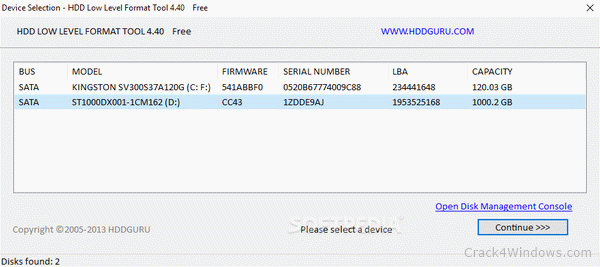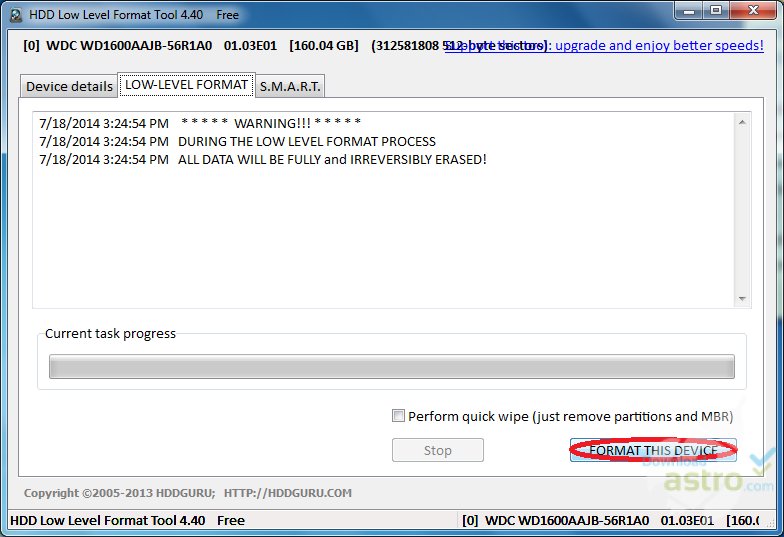- HDD Low Level Format 4.40 Serial Key: NFLF-WTWA-ZPP9-D3SN H2X5-VV2H-MQ8L-ZN6E N59F-T3EQ-5BHJ-KZXM ZVK4-QLTX-YUA9-R68N.
- HDD LLF Low Level Format Tool can erase and low-level format an SATA, IDE, SAS, SCSI or SSD hard disk drive. It also works for any USB and FIREWIRE external drive enclosures as well as SD, MMC, MemoryStick and CompactFlash media. It is provided by its developer free for home use, but requires a license for commercial use.
- Installing the HDD Low Level Format Tool download: HDDGURU provides their software as a Windows Executable file and therefore installation is as easy as downloading the file HDDLLFsetup.4.40.exe and running it directly after retrieving it.
A secure wipe basically performs a low-level format so that the entire disk is overwritten with 0’s. Other software will write junk data multiple times over the disk so that there is no trace of what was there before. Either way, no one is going to be able to get the original data off the hard drive because it’ll be completely gone.
- Best Low Level Format Tool
- How to Low Level Format Hard Drive with HDD Low Level Format Tool
- How to Partition and High Level Format Hard Drive with a Partition Manager
- Low Level Format (LLF) FAQs
Best Low Level Format Tool
Low level format of the hard disk is the most thorough way to initialize the hard disk. After the low level format of hard disk, the original saved data will be lost, so it is generally undesirable to perform low-level formatting on the hard disk. But when the hard disk has a certain type of bad sectors, in order to use the hard disk normally, you have to format the hard disk at a low level.
What's the best low level format tool that facilitates a hard drive formatting? HDD Low Level Format Tool from HDDGURU receives positive feedbacks from personal/home users as well as commercial/professional users.
HDD Low Level Format Tool is an outstanding disk formatter for low level hard disk drive formatting.
- Compatible with Windows XP, Vista, 7, 8, Server 2003, 2008, and 2008R2
- Low level format a SATA, IDE, SAS, SCSI, USB, Firewire, and SSD hard disk drive
- Support most popular hard drive brands, like Seagate, Samsung, Western Digital, Toshiba, Maxtor, etc.
- Work with any USB and firmware external drive enclosures as well as SD, MMC, MemoryStick and CompactFlash media.
- Free for personal/home use with speed limitation (the speed limit is 180 GB per hour, or 50 MB/s)
How to Low Level Format Hard Drive with HDD Low Level Format Tool
By using the HDD Low Level Format Tool, the hard drive low level formatting shall become easier and faster. Even a computer novice could make full use of it. Simply follow the guide to low level format a USB drive, pen drive, SD card, external hard drive, and more.
- Warning
- Low level format a USB drive or hard disk drive will erase the whole disk surface. After that, you can’t recover data from the hard drive any more even using professional data recovery software.
Step 1. Google 'HDD Low-Level Format', pick up an official site or CNET download site to download and install it on PC.
Step 2. Plug your HDD or USB drive into the computer and launch the low-level format tool.

Step 3. Select the desired drive and click Continue. Confirm the option by clicking Yes.
Step 4. Select 'Low-Level Format' in Tab to start the low-level formatting process.
Hdd Llf Low Level Format Tool
Partition and High Level Format a Hard Drive After Low Level Format
The purpose of complete low-level formatting of a hard drive is to zero-filling it so that erased data can never be restored. So, behave cautiously while choosing this type of formatting process.
It doesn't finish yet after low level format your hard drive if you want to put it in normal use. The hard disk must undergo three processing steps: low level format, partition, and high level format (hereinafter referred to as formatting) before the computer can use them to store data.
Hence, take more steps after using HDD low level format tool. Use EaseUS Partition Master to help you partition and format partitions on the low level formatted hard drive simply.
Partition and Format Hard Drive with a Partition Manager
In the steps of partitioning and formatting the hard disk, it is necessary to create partitions and logical disks to format the hard disk. You can create either FAT or NTFS partition according to the physical hard disk capacity.
And don't panic if the partition file is formatted incorrectly, You can still use EaseUS partition management software to convert FAT32 to NTFS on Windows 10, 8, 7.
Partition Hard Drive/Create a Partition

Step 1: Run EaseUS Partition Master, right-click the hard drive partition you intend to format and choose 'Format'.
Step 2: In the new window, set the Partition label, File system (NTFS/FAT32/EXT2/EXT3), and Cluster size for the partition to be formatted, then click 'OK'.
Step 3: Then you will see a warning window, click 'OK' in it to continue.
Step 4: Click the 'Execute Operation' button in the top-left corner to review the changes, then click 'Apply' to start formatting the partition on your hard drive.
Move/Resize Partition
As a professional disk management software, EaseUS partition management tool can help you easily move or resize partition so that your hard disk can play the maximum efficiency.
Step 1: Locate the drive/partition
Which drive/partition do you want to adjust its size? Right-click on it and choose 'Resize/Move'.
Step 2: Resize the partition

You can either shrink the selected partition or extend it.
To shrink the partition, simply use your mouse to drag one of its ends into unallocated space. Expand the 'Advanced Settings' list, where you can see the exact disk space for each partition. Once done, click 'OK'.
Fig. 1 Unallocated space before the drive.
Fig. 2 Unallocated space after the drive.
To extend the partition, make sure that there is unallocated space aside (if there isn't, follow the above steps to create some). In the same way, drag your mouse towards the unallocated space. Click 'OK'.
Fig. 3 Add unallocated space into the partition
Step 3: Apply changes
At this step, you will see the new disk partition information & diagram.
To save changes, click the 'Execute Operation' button and then 'Apply'.
Other practical key features of EaseUS Partition Master are:
- Clone whole disk or a certain partition without any data loss
- Merge partition to solve the low disk space issue
- Wipe out your disk completely to save all confidential and sensitive data
- Convert partition between logical and primary partition,
- Convert MBR disk to GPT or GPT disk to MBR
Knowledge About Low Level Format (LLF)
Low-level formatting is recognized as one of the three disk formatting processes, the others are partitioning and high-level formatting.
By wiki's explanation, low-level formatting marks the surfaces of the disks with markers indicating the start of a recording block and other information like block CRC to be used later, in normal operations, by the disk controller to read or write data. This is intended to be the permanent foundation of the disk and is often completed at the factory.
Pros
Low-level formatting is extremely helpful and significant when hard disk drive or some removable storage devices developed bad tracks, such as track 0 bad, or Windows was unable to complete the format due to write protection. Besides, severe computer virus infection.
Cons
Low-level formatting does damage to the hard drive and accelerates its death. What's more, it's incredibly time-consuming. It is estimated that low-level format a hard drive of 320GB takes about 20 hours or even longer.
If you have to do low level disk formatting, there are three typical approaches, including DOS command, inbuilt disk utility of disc or USB drive, and third-party low-level format tool (demonstrated in this article).
To Sum Up
After low level format, partition, and high level format, your hard drive can be perfectly put in use even after experiencing a dead moment. For any problem during the process, you can contact our technical support for help via live chat or email support: [email protected].
Low Level Format FAQs
Here are a few questions related to low level format on Windows 10. If you also have any of these problems, you can troubleshoot here.
1. What is low level formatting?
Low level format is to reset the contents of the disk, restore the factory state, divide the cylinder and the track, and divide the track into several sectors. Each sector is divided into the identification part ID, the interval GAP, and the data District DATA, etc. Low level formatting is a job before high-level formatting. Low level format can only target one hard disk and cannot support a single partition. Each hard drive has been low level formatted by the hard drive manufacturer when it leaves the factory, so users usually do not need to perform low level formatting operations.
2. Does low level format erase all data?
Low level format means clearing all sectors, including partition tables, boot sectors, etc.. It is a very long, but quite effective way to delete private data, boot sector viruses, C-Dilla data, and a few more. Low level formatting is a lossy operation, which has a certain negative impact on the life of the hard disk.
3. How do I format a low level hard drive?
You can use HDD low level format tool to low level format a hard drive:
Step 1. Download and run HDD LLF Low Level Format Tool on your computer.
Step 2. Plug your HDD or USB drive into the computer and launch the low-level format tool.
Step 3. Select the desired drive and click 'Continue'. Confirm the option by clicking Yes.
Step 4. Select 'Low-Level Format' in the tab to start the low-level formatting process.
4. What is the difference between low level format and standard format?
Download Hddguru Low Level Format Full Crack Download
Formatting is divided into high level formatting and low level formatting. High level format simply clears data on the hard disk, generates boot information, initializes the FAT table, and marks logical bad sectors. The low level format divides the hard disk into cylinders and tracks and then divides the tracks into several sectors, and each sector is divided into an identification part ID, a partition area, a GAP, and a data area DATA. Low level format is a job before high level format.